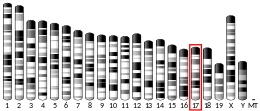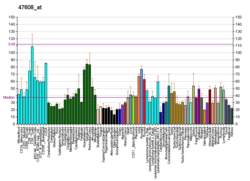TJAP1
Tight junction-associated protein 1 is a protein that in humans is encoded by the TJAP1 gene.[5][6]
Interactions
TJAP1 has been shown to interact with DLG1.[5]
gollark: You can buy used gaming laptops at fairly okay pricing.
gollark: Discretized.
gollark: Did you know? We have now discretized bees.
gollark: Windows costs them a significant thing of that, I think.
gollark: Unlike yours.
References
- GRCh38: Ensembl release 89: ENSG00000137221 - Ensembl, May 2017
- GRCm38: Ensembl release 89: ENSMUSG00000012296 - Ensembl, May 2017
- "Human PubMed Reference:". National Center for Biotechnology Information, U.S. National Library of Medicine.
- "Mouse PubMed Reference:". National Center for Biotechnology Information, U.S. National Library of Medicine.
- Kawabe H, Nakanishi H, Asada M, Fukuhara A, Morimoto K, Takeuchi M, Takai Y (Dec 2001). "Pilt, a novel peripheral membrane protein at tight junctions in epithelial cells". J Biol Chem. 276 (51): 48350–5. doi:10.1074/jbc.M107335200. PMID 11602598.
- "Entrez Gene: TJAP1 tight junction associated protein 1 (peripheral)".
Further reading
- Maruyama K, Sugano S (1994). "Oligo-capping: a simple method to replace the cap structure of eukaryotic mRNAs with oligoribonucleotides". Gene. 138 (1–2): 171–4. doi:10.1016/0378-1119(94)90802-8. PMID 8125298.
- Suzuki Y, Yoshitomo-Nakagawa K, Maruyama K, et al. (1997). "Construction and characterization of a full length-enriched and a 5'-end-enriched cDNA library". Gene. 200 (1–2): 149–56. doi:10.1016/S0378-1119(97)00411-3. PMID 9373149.
- Strausberg RL, Feingold EA, Grouse LH, et al. (2003). "Generation and initial analysis of more than 15,000 full-length human and mouse cDNA sequences". Proc. Natl. Acad. Sci. U.S.A. 99 (26): 16899–903. doi:10.1073/pnas.242603899. PMC 139241. PMID 12477932.
- Mungall AJ, Palmer SA, Sims SK, et al. (2003). "The DNA sequence and analysis of human chromosome 6". Nature. 425 (6960): 805–11. doi:10.1038/nature02055. PMID 14574404.
- Ota T, Suzuki Y, Nishikawa T, et al. (2004). "Complete sequencing and characterization of 21,243 full-length human cDNAs". Nat. Genet. 36 (1): 40–5. doi:10.1038/ng1285. PMID 14702039.
- Xavier R, Rabizadeh S, Ishiguro K, et al. (2004). "Discs large (Dlg1) complexes in lymphocyte activation". J. Cell Biol. 166 (2): 173–8. doi:10.1083/jcb.200309044. PMC 2172307. PMID 15263016.
- Beausoleil SA, Jedrychowski M, Schwartz D, et al. (2004). "Large-scale characterization of HeLa cell nuclear phosphoproteins". Proc. Natl. Acad. Sci. U.S.A. 101 (33): 12130–5. doi:10.1073/pnas.0404720101. PMC 514446. PMID 15302935.
- Gerhard DS, Wagner L, Feingold EA, et al. (2004). "The status, quality, and expansion of the NIH full-length cDNA project: the Mammalian Gene Collection (MGC)". Genome Res. 14 (10B): 2121–7. doi:10.1101/gr.2596504. PMC 528928. PMID 15489334.
This article is issued from Wikipedia. The text is licensed under Creative Commons - Attribution - Sharealike. Additional terms may apply for the media files.





